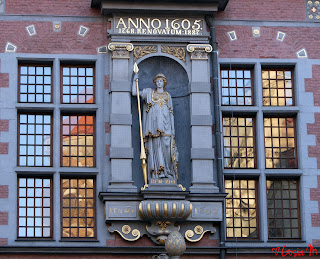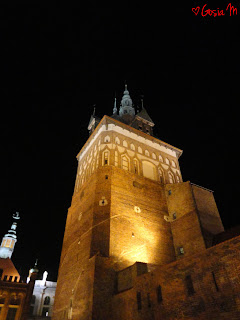as I promised you last time, today I'll tell you something more about Gdańsk [Poland] and about St. Dominic's Fair...
Gdańsk is a Polish city on the Baltic coast, at the center of the country's fourth-largest metropolitan area. The city lies on the southern edge of Gdańsk Bay (of the Baltic Sea), in a conurbation with the city of Gdynia, the city of Sopot, and suburban communities, which together form a metropolitan area called the Tricity (Trójmiasto), with a population near 740,000. Gdańsk itself has a population of 455,830, what making it the largest city in the Pomerania region of Northern Poland.
Gdańsk is Poland's principal seaport as well as the capital of the Pomeranian Voivodeship. It is also historically the largest city of the Kashubian region. The city is close to the former late medieval/modern boundary between West Slavic and Germanic lands and it has a complex political history with periods of Polish rule, periods of German rule, and extensive self-rule, with two spells as a free city. It has been part of modern Poland since 1945.
Gdańsk is situated at the mouth of the Motława River, connected to the Leniwka, a branch in the delta of the nearby Vistula River, whose waterway system supplies 60% of the area of Poland and connects Gdańsk to the national capital in Warsaw. This gives the city a unique advantage as the center of Poland's sea trade. Together with the nearby port of Gdynia, Gdańsk is also an important industrial center. Historically an important seaport and shipbuilding center, Gdańsk was a member of the Hanseatic League.
The city has many fine buildings from the time of the Hanseatic League. Most tourist attractions are located along or near Ulica Długa (Long Street) and Długi Targ (Long Market), a pedestrian thoroughfare surrounded by buildings reconstructed in historical (primarily 17th century) style and flanked at both ends by elaborate city gates. This part of the city is sometimes referred to as the Royal Road as the former path of processions for visiting kings.
The National Museum contains a number of important artworks, including Hans Memling's Last Judgement.
The museum ship SS Soldek is anchored on the Motława River and was the first ship built in post-war Poland.
In the 16th century, Gdańsk hosted Shakespearean theatre on foreign tours, and the Danzig Research Society founded in 1743 was one of the first of its kind. Currently, there is a Foundation Theatrum Gedanensis aimed at rebuilding the Shakespeare theatre at its historical site. It is expected that Gdańsk will have a permanent English-language theatre, as at present it is only an annual event.
did you hear about CiuCiu? I don't think so. CiuCiu is the only one and smallest sweets’ manufacture in Poland, based on the 17th Century formula, with combination of love and passion.they offer candy Roc's and pillows as well as lollipops. in the manufactory you can find assortment with range of flavors, not only fruits flavors like lemon, apple or melon but flavors such as amaretto, cappuccino with chocolate, anise, thyme.
photos from Gdańsk, please...
Black Pearl
St. Dominic’s Fair is one of the biggest trade and cultural open-air events in Europe, organized in the Main City – the representative part of Gdańsk, Poland.
with 750 years of successful tradition, the history of the Fair goes back to the year 1260, when it was established by the decree of Pope Alexander IV. However, it was the Dominican Order, that came up with the idea of the event and, for this reason, the Fair was named after them.
for many years, since its reactivation in 1972, the St. Dominic’s Fair lasted for 2 weeks. In 2004, a decision was made to extend it up to 3 full weeks. Every year, about 1000 merchants, artists, artisans and collectors take part in the Fair, and it is visited by an average of 70.000 people daily, whose number usually doubles at weekends.
you can find here products from Poland but also from other countries, like Lithuania, Latvia, Germany, Austria, Sweden and such distant as Israel or Uzbekistan. all those foreign sellers offer products and souvenirs distinctive for their culture.
the plan of the Fair is divided into five parts: multibranch stalls (Szeroka, św. Ducha, Grobla I, Grobla II Streets), craft articles and jewellery (Mariacka Street, Długie Pobrzeże, Rybackie Pobrzeże, Długi Targ), souvenirs and artists’ stalls (Długa Street, Długi Targ, Zielony Most), stalls of collectors and hobbyists (Wartka and Straganiarska Streets, Targ Rybny), gastronomic stalls (Targ Węglowy, Targ Rybny, Szeroka Streets).
what else you can find during St. Dominic's Fair? outdoor stages, festivals, fetes and concerts, demonstration of fireworks and laser lights, street parades, rock concerts, chamber and organ music concerts, sport events and competitions (St. Dominic’s Race).
photos, please...
something else...
memories from Gdańsk from UEFA Euro 2012 in Poland.
and something personal from Gdańsk...































































































No comments:
Post a Comment